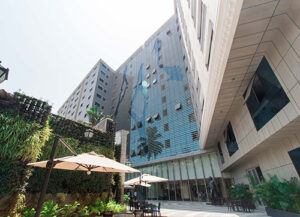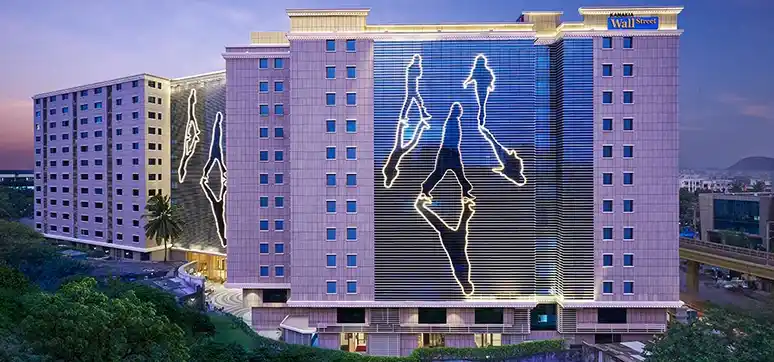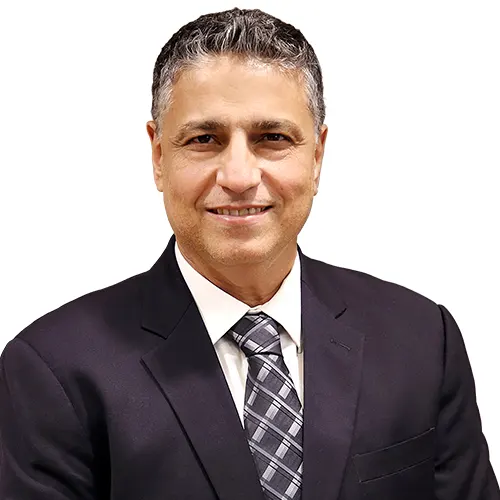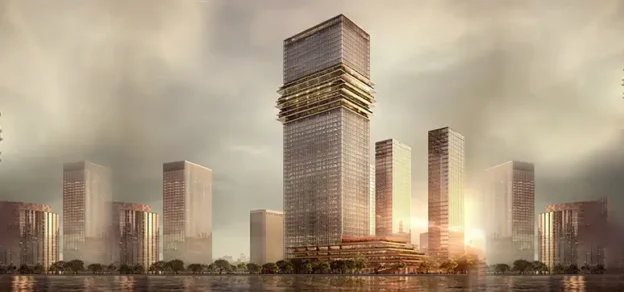The façade is one of the most important contributors to any building’s energy use and comfort parameters. In order to provide occupants with a comfortable environment, a façade must fulfil many functions, such as providing views to the outside, resisting wind loads, supporting its own dead load weight, allowing daylight to interior spaces, blocking unwanted solar heat gain, protecting occupants from outside noise and temperature extremes, and resisting air and water penetration.
The highly glazed façade has become an important component today. The common use of glass in building envelopes has greatly fascinated the ‘green building’ and construction designers and owners. However, most of those buildings have an intense reflection or use overly reflected glass and face severe internal comfort challenges. Only robust HVAC systems can solve this, resulting in substantial capacity, costs and environmental penalties.
The future façades will be much more interactive, environmentally friendly and design innovative. Integrating technologies into constructive façade management approaches helps to aspire for a greener and more sustainable future and to ensure that collaborative initiatives play a role in sustainability objectives. Skins will incorporate dynamic or film components in future, creating a unique architecture with multiple materials and systems.
Materials Selection

Material selection is an important factor in designing sustainable façades. Improving the thermal performance of building envelopes and minimising thermal bridging are extremely important design strategies for sustainable façades. Thermal bridging occurs inside a wall where a highly conductive substance such as metal support penetrates the isolating layer of the façade. It can influence the thermal efficiency of the wall dramatically and reduce its effective thermal resistance.
Material selection often influences the environment. Hence, choosing products that have the least harmful impact on the environment is becoming increasingly necessary. The lifecycle evaluation methodology can be used to calculate the environmental impacts of material selection, where material quality, manufacturing processes, energy requirements and waste are measured to evaluate the overall cost of an item, representing the total amount of its environmental impact.
Self-Cleaning Envelopes: With high-rise buildings becoming more frequent, self-cleaning envelopes and finishes may help improve its notoriously difficult maintenance, dirt and smog safety. Cleaning glass façades can become an obsolete task with the help of these materials. Self-cleaning technology is not only beneficial for the care of large structures, small buildings or residences. The design gains sustainability when it comes to saving water and removing cleaning substances that can adversely affect the environment by reducing the need of cleaning.
Self-Healing Materials: Due to the environment, repeated use or unforeseen incidents, all products can be degraded over time. Sometimes an invasive solution is necessary to repair a small crack in a structure so that it can cause unwanted structural deficiencies. This question does not arise with self-healing materials anymore. Self-healing metal, concrete, and façades could increase the life expectancy of a building and dramatically reduce maintenance costs in the long run.
Controlling Solar Heat and Gain: Design strategies need to consider the conditions of the climate zone to minimise their impacts and reduce energy consumption. In cooling-dominated climates, protection from sun and direct solar radiation become more important. In mixed climates, combined strategies that balance solar exposure and access to daylight must be implemented.

The orientation of a building determines its exposure to sunlight. Since the angle of the earth relative to the sun varies throughout the year and the sun moves across the sky during the day, solar exposure on a façade is continually changing. Strategies for controlling solar heat gain depend on the building’s orientation. The optimal orientation of the building, from the perspective of solar heat gain, balances desirable solar heat gain during winter months with solar shading during summer months. In very hot climates, solar heat gain must be kept as low as possible during the entire year, but especially during summer months. In cool climates, more balance is needed across the seasons. In winter months, solar exposure should be used to passively heat the building.
Fenestration Elements:
Components of fenestration (windows, curtain walls, clerestories) are essential elements of façade design from an aesthetic and performance perspective. They allow natural light to enter interior space, but also allow heat transfer between the outside and inside. Fenestration elements affect a building’s overall energy consumption, as well as its occupants’ well-being, health, comfort, and productivity. When choosing fenestration materials, specific properties of glass should be considered, such as U-values, SHGC and visual transmittance.

The design of the fenestration framing system is also important. Recent developments in fenestration products use new advances in building technology to allow transparent, yet energy-efficient façades. Glazing units can be insulated using two, three or more layers of glass. The spaces between the glass layers can be filled with inert gases or aerogel insulation to lower the U-value of the unit. Low-e, reflective, or ceramic frit coatings can be applied to the glass to reduce transmission of solar heat gain. Interlayer films within the laminated glass can also provide shading.
Recent developments in fenestration products use new advances in building technology to allow transparent, yet energy-efficient façades. Glazing units can be insulated using two, three or more layers of glass. The spaces between the glass layers can be filled with inert gases or aerogel insulation to lower the U-value of the unit. Low-e, reflective, or ceramic frit coatings can be applied to the glass to reduce transmission of solar heat gain.
Interlayer films within the laminated glass can also provide shading. All façades create barriers between the exterior and interior environment, providing building occupants with thermally, visually, and acoustically comfortable spaces. Sustainable and high-performance façades must do more; specifically, they must allow optimal levels of comfort using the least amount of energy. To achieve this high performance, designers need to consider many variables— climate and climate-based design approaches, thermal performance, daylighting, solar shading, glare, moisture transport, materials and their environmental impact, etc.
Factoring Natural Light & Ventilation Kanakia WallStreet, Mumbai

Situated in Andheri, Kanakia WallStreet boasts of a prime location in the commercial district of Mumbai. Andheri is the second biggest commercial micro-market in India and accounts for 34% of the commercial building market share in the city. Situated on the arterial Andheri-Kurla Road, the project is easily accessible to the highway, metro station, and railways station. The connectivity further extends to the domestic and international airport terminals, both in a radius of less than 5 km.
The architecture of Kanakia WallStreet reflects the heavy stonework buildings that lace the kilometre-long Wall Street (New York). The design concept, based on functionality, is a mixture of the classical architectural style of the original Wall Street with a modern twist of our own. The classical gothic style fades away with the introduction of double-glazed glass and aluminium fins on the façade. Horizontal fins between the cladding run end-to-end in varying widths which resemble human figure silhouettes. The unique façade creates character and dynamism. Beyond the design element, the façade blinds cut off the direct heat onto the structure. The double-glazed glass further reduces the heat into the structure as well as reduces the impact of noise from the arterial road and metro across.
The building symbolises the busy life and the effort it takes to achieve success. Along with Laminam tiles, dry cladding on the façade, materials such as aluminium fins and DGU and SGU glass have also been used. The dry cladding system that has been used is a much safer option than wet cladding as it does not rely on any adhesive.

Factoring natural light and ventilation, windows and glazing have been provided of sufficient size to cater to the needs of every space. The design ensures that there is an economical use of glass, keeping in mind the weather of Mumbai. The design also ensures that there is no excess load on the airconditioning and assists with energy conservation. The glass itself has been ceramic fritted in shape of the human figures to reduce excessive glare in the office spaces.
Kanakia WallSteet offers 10,00,000 Sq ft of office space, ranging from 800 Sq ft to 50,000 Sq ft. Along with the large floorplates, the 11’6” (approx.) floor to floor height helps create dynamic offices. The project features amenities that include The WallStreet news room and 24×7 news display, an executive lounge, as well as valet and concierge services.
One of the key design considerations is the emphasis on personal health and well-being of the modern age entrepreneurs and employees. The landscaped terrace gardens and cafes, indoor gaming zone, and library make for ideal breakout spaces. Sleeping pods have been designed owing to those who pull the late nights and all-nighters in the competitive environment. The multi-level carpark offers a solace to the lack of parking facilities on the busy arterial road, with advanced security and surveillance features.
QUICK FACTS:
Project: Kanakia Wallstreet, Mumbai
Location: Andheri, Mumbai
Client: Kanakia Spaces Realty Pvt. Ltd.
Type: Commercial
Architect: Ar. Reza Kabul
Commencement Date & Completion Date: 2011 – 2018














